Because I’m an architecture nerd, I get really excited when I see distinctive buildings. It’s not uncommon for me to say, “That’s one of my favorite buildings” or “that’s one of my favorite architecture styles.” But in the case of Spanish-style architecture, it really is my favorite. Maybe it’s because it’s so quintessential California. Or reminds me of classic Hollywood glamour. I’m not sure, but it feels like home. Certainly, it is perfect for the weather and the Spanish heritage we enjoy here.
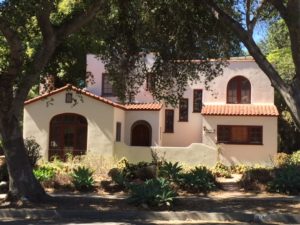
Spanish Colonial Revival first became popular in California around 1915 after the Panama-California Exposition in San Diego. After that, the style caught on and started popping up all over California. It fit in perfectly with what was going on with architectural trends at the time—the revival of older and classic styles. Today Spanish Colonial Revival is considered a quintessential part of Los Angeles architecture.
One of the big appeals of Spanish houses is how they blend indoors and outdoors. Homes often have large windows that flood rooms with natural sunlight. Some buildings—either residential or commercial—are even U-shaped to form an atrium area. When windows or doors are open, there is a cross-breeze and little distinction between the house and the yard.
There are several distinctive characteristics of Spanish Colonials so let’s take a look at some of the most popular.
Wrought Iron
Wrought iron is typically found both inside and outside Spanish houses, from decorative bars over the windows to railings to light fixtures. It’s a timeless element that lasts forever because of its durability. Wrought iron is used in more than just Spanish Colonial—you can find great examples in Craftsman architectural elements for instance—but it’s an easy way to convey that Spanish feeling.
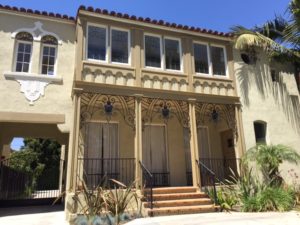
Tiles
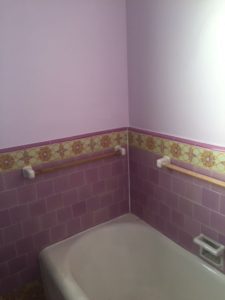
There are multiple types of tiles found in Spanish homes, starting with the red tile roofs. Terracotta tiles are often found both inside and outside and usually come in a rich brownish red color. It’s used for almost all roofs and if you use it on the ground it’s a perfect way to extend indoor floors all the way outside without any seams.
Another classic element is hand-painted tiles that are typically found on stair risers. Often each step has a different pattern in complementary colors but that’s up to you. This is the perfect area to go wild with vibrant colors or crazy designs because these are accents rather than large focal points. But painted tiles aren’t just for stairs. They’re also found around fireplaces, in floors, kitchen back splashes—anywhere that could stand a little dose of color, really.
Arches
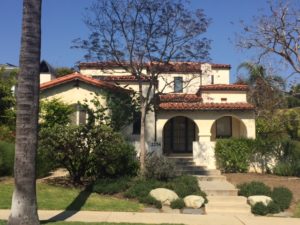 Doors, windows and room transitions are frequently arched and give the building a graceful look but they’re also really functional. Modern building standards and techniques are much more sturdy than they were centuries ago, but old school builders realized that arches were stronger than squared-off windows and doors. These days it’s more decorative than anything but arches still evoke old world charm.
Doors, windows and room transitions are frequently arched and give the building a graceful look but they’re also really functional. Modern building standards and techniques are much more sturdy than they were centuries ago, but old school builders realized that arches were stronger than squared-off windows and doors. These days it’s more decorative than anything but arches still evoke old world charm.
Wood Beams
Exposed, dark wood beams that span across ceilings typify Spanish style, especially in the common areas such as the living room.
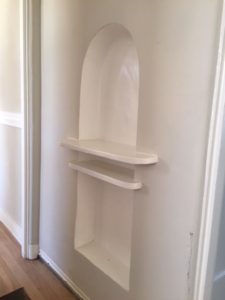
Alcoves
A lot of older homes have little niches and alcoves for, say, a telephone and Spanish Colonials are no different. They’re versatile so the only limits are your imagination. Most people don’t have much use for telephone alcoves anymore, but smaller niches can store anything from knick-knacks to books to family photos. Some are even large enough to throw a pillow down and sit in.
Ornate Doors
Some doors are more ornate than others but the typical look is dark wood. This harkens back to when doors were handmade and carved with decorative elements. Bigger, fancier houses tended to have more details back in the day but now homeowners can have just about anything they want. Common accents usually include wrought iron rivets and hardware, especially for front doors, to make the look more authentic.
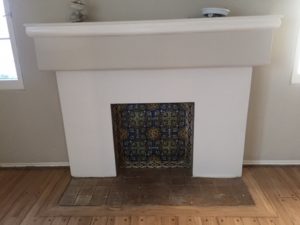
Fireplaces
A lot of older homes have fireplaces, although improved heating systems make fireplaces less of a necessity and more of a decorative feature. Still, they top homeowner wish lists and make a great focal point. In Spanish-style houses, fireplaces are pretty versatile. They come in stucco, tile, brick, terracotta, wood mantles—you name it.
Stucco Exterior
Typically, Spanish exteriors are stucco and usually in various shades of white, beige and cream, although recent years have seen creativity in house colors, such as terracottas, browns, yellows, pinks and grays. Add pops of color to trims and landscaping elements such as flowerpots and fountains.
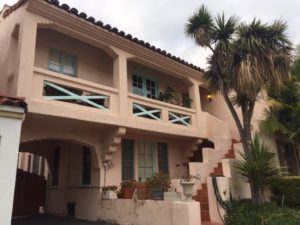

Great article Elisa! My husband and I recently purchased a Spanish style home and we are in the process of doing some remodeling. As you suggested, we are keeping all of the original tile because it is truly one of a kind. An interesting tidbit….In Mexico City, during the 1930s and 40s, the Mexican government actually offered tax incentives for residents to build Spanish Colonial homes. There are a couple of websites that offer Spanish homes, exclusively, currently listed for sale. It does seem to be a popular choice! Thank you so much for sharing this information!